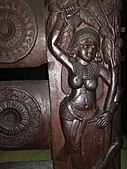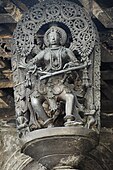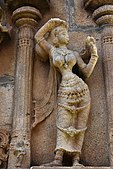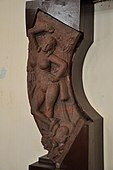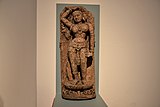Salabhanjika
A salabhanjika or shalabhanjika is a term found in
In Buddhist literature, salabhanjika also refers to an ancient Indian festival, one celebrated when sala tree blossoms in the context of Buddha's life.[3]
In literature, apart from the statue meaning, Salabhanjika can mean a doll, or fairy, or a seductress (harlot) depending on the context.
In Buddhist sites, reliefs on
Etymology

The word śālabhañjikā is a compound Sanskrit word consisting of śālā and bhañjikā. The word bhañjikā means 'breaking, interrupting". The word śālā means any "house, space, enclosure, wall, court" – such as in dharmaśālā (rest house) or gośālā (resting space for cows).[6] The same word also refers to the sala tree, a valuable timber tree used to construct homes and other buildings.[6] According to Vogel, a Sanskrit scholar, the different meanings of the word salabhanjika in the Indian traditions, may be linked to the respective significance of sala tree, the Buddhist tradition associating it with the birth of Buddha, while Hindu and Jain traditions using the same tree as timber for making statues and other objects of art.[3]
Vogel states that the word salabhanjika is found neither in the Vedic literature nor in Pali literature and nor in the major Indian epics, but appears in Indian classical literature of early 1st-millennium CE such as
The word salabhanjika appears with uddalakapushpa-bhanjika and asokapushpaprachayika as ancient games in early Hindu Sanskrit texts, says Sivaramamurti – an art historian and Sanskrit epigraphist.[9] These games were played by girls who collected flowers from the Sala, Asoka and other trees, then arranged them in colorful patterns or decorated their hair with them. This cultural event inspired sculpture, states Sivaramamurti.[9] He concurs with Vogel and states that over the centuries, the word salabhanjika came to mean "any statue and nothing more", irrespective of the presence or absence of tree, whether female or male, in architecture or literature.[9]
Vogel, Acharya, and other scholars concur that in the arts and literature of the Hindus and Jains, the term salabhanjika has simply meant any statue on any pillar, wall, or in any hall.[7][10][8]
Locations
In the Buddhist traditions, among the renowned shalabhanjika sculptures with sal tree are found in Bharhut and at the gateways (Torana) of
In the Hindu traditions, among the renowned salabhanjika sculptures without sal tree are those at the 12th-century
. Some of the salabhanjika in Hindu and Jain temples may include decorations of flower or vine motifs behind or to the side of the statue or relief.Salabhanjikas have been found in many historic temples of India, Nepal, Cambodia, Vietnam and Indonesia. These include the
-
Buddhist, Bharhut, Madhya Pradesh
-
Buddhist, 11th-century north India, now at Museo d'Arte Orientale (Turin, Italy)
-
Hindu, Belur, Karnataka
-
Hindu, Halebidu, Karnataka
-
Hindu, Srirangam, Tamil Nadu
-
Hindu, Sirpur, Chhattisgarh
-
Hindu, Mathura, Uttar Pradesh
-
Hindu, 12th-century Odisha, now at Altes Museum, Berlin
-
Hindu, Panauti Indreshwar Temple, Nepal
-
Hindu (with tree motif), Phanom Rung, Thailand
Related iconography
The sal tree (Shorea robusta) is often confused with the
See also
- Caryatid, a similar element in Western architecture
- List of tree deities
- Yakshini
References
- ^ "Temple Strut with a Tree Goddess (Shalabhanjika)". The Metropolitan Museum of Art. Retrieved 11 May 2013.
- ^ OCLC 6828640.
- ^ a b c d J Ph Vogel (1929). "The woman and tree or Salabhanjika in Indian Arts and Literature". Acta Orientalia. 7: 202–209.
- ^ H.D. Velankar (1936). "Apabhramsa Meters". The Journal of the University of Bombay. V (9): 57–58.
- ^ Heinrich Zimmer, Myths and Symbols in Indian Art and Civilization. (1946)
- ^ a b Monier Monier Williams (1994 updated), Sanskrit English Dictionary, शाल śāla śālá, page 260
- ^ a b J Ph Vogel (1929). "The woman and tree or Salabhanjika in Indian Arts and Literature". Acta Orientalia. 7: 206–219.
- ^ OCLC 697763683.
- ^ OCLC 143045, pp. 1-2
- JSTOR 592847.
- ISBN 978-3-424-00898-2
- ISBN 978-3-424-00897-5

